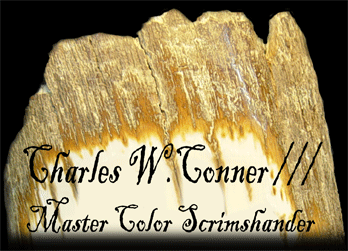

" Where Your Art Matters "
Artist Owned and Operated since 1996


Charles' career in scrimshaw started in 1974 in the birthplace of scrimshaw, New Bedford, Massachusetts. He was tutored by his high school art teacher. Since that time, he has fully mastered the exacting technique of color scrimshaw. Charles is most noted for his true-to-life renditions of wildlife and floral motifs. He works long hours, just to meet the demand and still maintains a very high level of quality. Every piece is a unique work of art, accompanied by only the finest woods in the world as fittings and cradles. His works can only be found in a few of the finest galleries.
Charles' scrimshaw is done solely by hand. The same way it was done by early whalers. He engraves freehand with the use of a metal scribe which creates thousands of tiny scratches which comprise each scene. Everywhere he scratches it opens up pores that accept ink. There is absolutely no margin for error. A slip of the wrist can be disastrous!
The manual dexterity, eyesight, patience and creativity involved produces incredible one-of-a-kind works of art on beautiful mediums such as legally acquired ivory, fossilized mammoth tusk, and fossilized walrus tusk.
In the world of paintings, many of the greatest artists have already come and gone. The Rembrandts, Picassos and Monets have already made their mark on history and set the standards for artists in every era since. In the world of scrimshaw, the greatest artists that have ever picked up a scribe are alive today. One of which is Charles Conner III. Charles lives and works in the lakes country of Northeast Oklahoma where he is establishing new standards in the world of scrimshaw that were never dreamed of before. A dramatic level of competition has elevated the craft to a new form of fine art.
This particular generation of scrimshanders represents the
"Renaissance of Scrimshaw".

